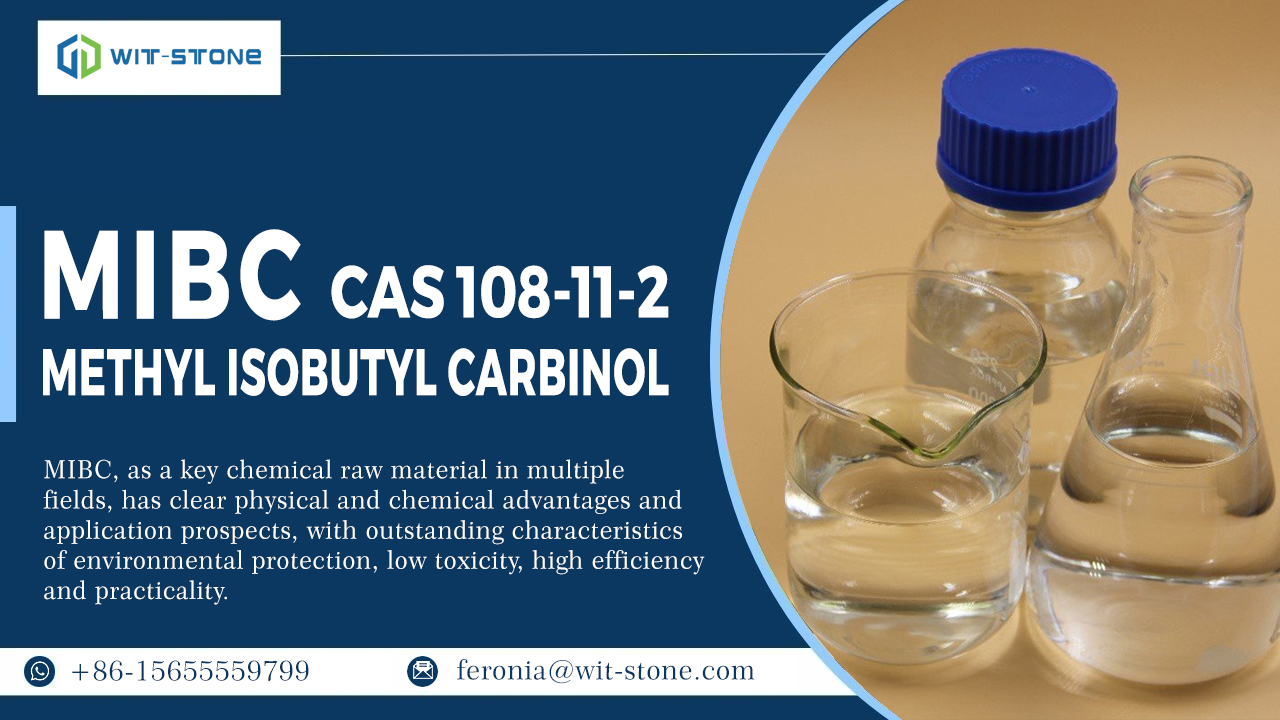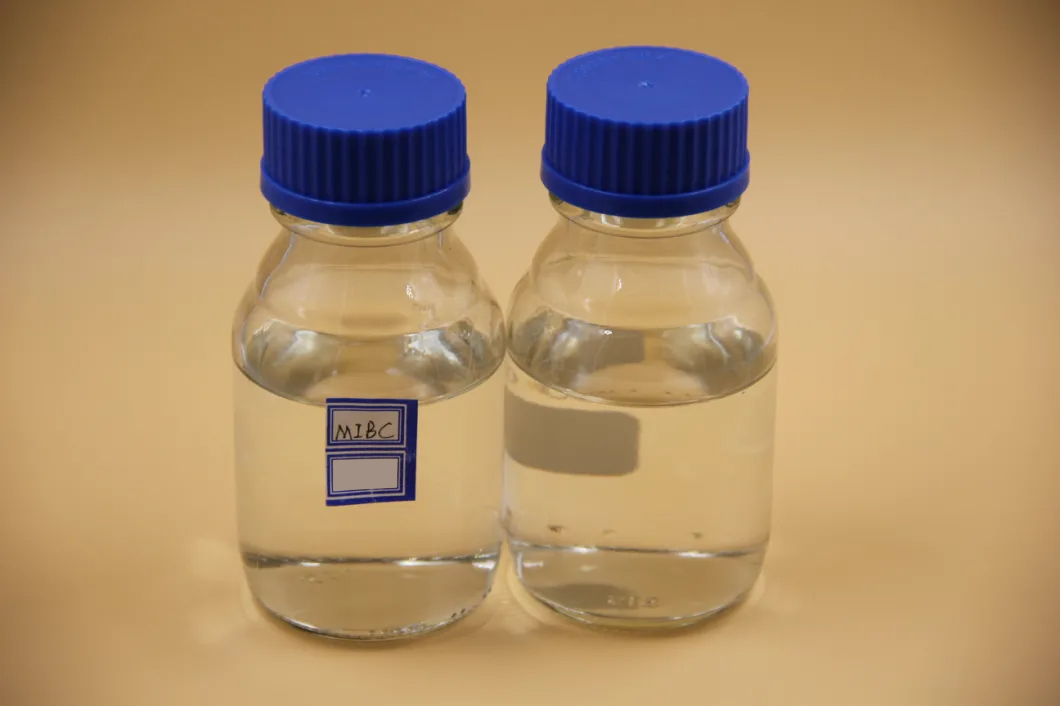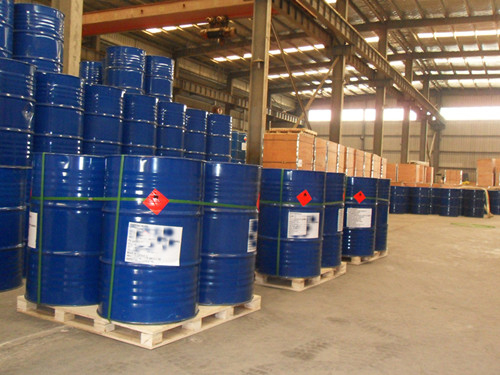
1. Basic Overview
Methyl Isobutyl Carbinol (MIBC), also known by its chemical name 4-Methyl-2-pentanol (CAS No. 108-11-2), is a colorless to pale yellow transparent branched secondary alcohol with a mild alcohol-like odor. It has a density of approximately 0.8075 g/cm³ and a boiling point of 131.6 ℃. It is slightly soluble in water but miscible with alcohols and most organic solvents. MIBC exhibits low evaporation rates and excellent solubility.

2. Key Properties
| Property | Value |
|---|---|
| Molecular Formula | C₆H₁₄O |
| Molecular Weight | 102.17 |
| Boiling Point | 131.6 ℃ |
| Density (at 20 ℃) | ≈0.806–0.808 g/cm³ |
| Water Solubility | ≈1.6–1.7 % (mass ratio) |
| Flash Point (closed cup) | ≈40–41 ℃ |
MIBC offers good thermal stability and a relatively high flash point, classifying it as a flammable liquid. Its vapor pressure is moderate, and it remains stable under typical storage and handling conditions.

3. General Application Fields
① Industrial Solvents & Coatings
MIBC is widely used as a solvent for ethyl cellulose, nitrocellulose, phenols, oils, dyes, colloids, and natural resins. It is commonly applied in the production of paints, coatings, and printing inks.
② Intermediate for Organic Synthesis
As a chemical intermediate, MIBC plays a role in fine chemical synthesis, especially in the production of plasticizers, brake fluids, and lubricant additives.
③ Lubricant Additive Carrier
MIBC is used as a carrier or solvent in the production of lubricant additives like Zinc Dialkyl Dithiophosphate (ZDDP), which is known for its anti-wear and anti-corrosion properties.
④ Frother in Mineral Flotation
In mining, MIBC serves as a typical frothing agent in flotation processes for copper, molybdenum, coal, nickel, silicon, and copper sulfate ores, enhancing the separation of valuable minerals.
⑤ Solvent in Coatings & Inks
MIBC is employed as a co-solvent or slow-evaporating solvent in inks, coatings, and printing materials.
Additionally, MIBC finds niche applications in agrochemicals, electronic chemicals, personal care, packaging, and textiles.

4. Role in Industrial Synthesis
① Producing Lubricant Additives
MIBC is instrumental in the synthesis and dispersion of ZDDP, a widely used anti-wear additive in lubricating oils. It serves as a solvent carrier, promoting product stability and enhancing performance. It also appears in certain mechanical oil formulations to improve lubrication and durability.
② Intermediate in Fine Chemicals
MIBC is used in:
• Producing plasticizers, including phenol and acetate ester series;
• Synthesizing organic alcohols for brake fluids;
• Acting as a solvent or reactive medium in dyes, petroleum, rubber, resins, waxes, nitrocellulose, and ethyl cellulose.
③ Raw Material Conversion Path
MIBC is often co-produced with MIBK (Methyl Isobutyl Ketone) using acetone via aldol condensation, dehydration, and hydrogenation.
As of 2013, global flotation agent output reached approximately 100,000 tons, with MIBC accounting for a significant portion. With rapid industrial development in China, MIBC has become a rising star in downstream applications.

5. Application in Mining & Flotation
① Frother Function & Mechanism
In flotation, MIBC promotes the formation of stable froths on the surface, allowing valuable metal sulfide particles to attach and be recovered efficiently.
MIBC is favored for its low volatility, strong froth stability, and minimal environmental impact, making it widely used in copper, molybdenum, and coal flotation.
② Mineral-Specific Applications
• Copper & Molybdenum Flotation: Enhances the recovery rates of copper and molybdenum sulfide ores.
• Coal Flotation: Improves impurity removal during coal processing.
• Nickel, Silicon, Copper Sulfate Ores: Effective in the flotation of polymetallic ores.
③ Market Trends
In 2013, the global consumption of MIBC for mining flotation reached about 100,000 tons, with sales nearing $200 million. North America and East Asia are the primary markets, driven by demand in metal sulfide and coal flotation.
With stricter environmental regulations, the demand for eco-friendly alternatives to phenolic frothers is growing, and MIBC's usage is expected to expand significantly in future flotation projects.

6. Safety and Environmental Considerations
Health & Toxicology
MIBC may cause mild irritation or narcotic effects when inhaled or absorbed through the skin. High concentrations may lead to dizziness or respiratory discomfort. It has low acute oral toxicity and is readily biodegradable in the environment, with low acute aquatic toxicity.
Safe Handling
MIBC should be handled in closed systems or well-ventilated areas. Avoid ignition sources and electrostatic discharge. During storage and transportation, fire prevention and static control measures are recommended.

7. Conclusion
Methyl Isobutyl Carbinol (MIBC), as a functional branched secondary alcohol, offers several advantages:
• Outstanding Physical Properties: Medium boiling point, low volatility, and high thermal stability;
• Wide Applications: From mineral flotation and lubricant additives to fine chemical synthesis and industrial solvents;
• Eco-Friendly: Biodegradable with low aquatic toxicity;
• Stable Market: Strong demand driven by mining expansion and environmental regulations.
As a critical chemical raw material, MIBC plays a vital role in industrial synthesis (lubricant additives, intermediates, solvents) and mining flotation (frother for copper, coal, sulfide ores). With its well-defined physical and environmental advantages, MIBC stands out as a “core performer” in the chemical industry.
You can place an order or ask any questions, please feel free to contact at feronia@wit-stone.com | +86-15655559799
Post time: Jul-23-2025